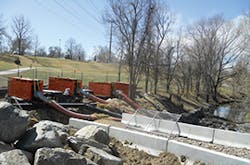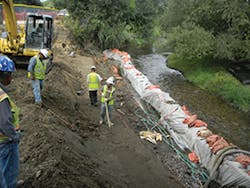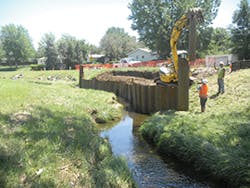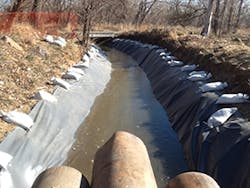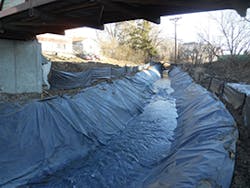Temporary Diversion Sizing When Working in Waterways
Editor’s note: This article first appeared in the September 2013 edition of Stormwater.
Temporary diversion methods are commonly used to reroute water from a stream or direct flows to a designated portion of the stream channel to allow for construction activities to take place in the stream, along the banks, or beneath the active channel. Temporary diversion methods are often required during the construction of detention ponds, dams, instream grade control structures, bank protection, utility installation, and other activities, including maintenance, that require working in waterways. Temporary diversion methods include temporary diversion channels, pump diversions (water is collected and pumped around the construction activities), piped diversions that operate via gravity, coffer dams, and other similar practices. The primary purpose of all temporary diversion methods is to allow for construction to occur in “dry” or dewatered conditions, providing conveyance of stream discharges and protecting water quality by passing upstream flows, up to a specified design event or threshold, around the active construction zone.
Editor's note: This article first appeared in the September 2013 edition of Stormwater. Temporary diversion methods are commonly used to reroute water from a stream or direct flows to a designated portion of the stream channel to allow for construction activities to take place in the stream, along the banks, or beneath the active channel. Temporary diversion methods are often required during the construction of detention ponds, dams, instream grade control structures, bank protection, utility installation, and other activities, including maintenance, that require working in waterways. Temporary diversion methods include temporary diversion channels, pump diversions (water is collected and pumped around the construction activities), piped diversions that operate via gravity, coffer dams, and other similar practices. The primary purpose of all temporary diversion methods is to allow for construction to occur in "dry" or dewatered conditions, providing conveyance of stream discharges and protecting water quality by passing upstream flows, up to a specified design event or threshold, around the active construction zone. [text_ad] The challenge of sizing temporary diversion methods when working in waterways is encountered across the nation. Little published guidance is available to determine the appropriate sizing methodology; typically it is considered a means and method choice of the contractor. However, limited guidance has been published indicating that temporary diversions should be sized to convey the two-year storm event. In the case of the Denver, CO, area, municipalities adopted this two-year temporary diversion method sizing criteria, which oftentimes, for smaller, short-duration maintenance projects, caused the temporary diversions to be oversized and cost more than all the other project costs combined. Therefore, the Urban Drainage and Flood Control District (UDFCD), which was established by the Colorado legislature in 1969 for the purpose of assisting local governments in the Denver metropolitan area with multi-jurisdictional drainage and flood control problems, published a revised Temporary Diversion Methods Fact Sheet as part of its Urban Storm Drainage Criteria Manual (USDCM), Volume 3, Construction Best Management Practices (BMPs) update. This USDCM is used by more than 30 local jurisdictions within the Denver area and has been used, with appropriate adaptations, as a source of drainage principles, policies, and criteria in municipalities elsewhere in the US and abroad. This article summarizes the temporary diversion method appropriate uses, design considerations, sizing methodology, and maintenance and removal guidance applicable to Denver and presented in the UDFCD Fact Sheet. [caption id="attachment_41768" align="alignleft" width="270"]- Will construction of a temporary diversion cause greater environmental impacts than if the project is constructed without a temporary diversion? This frequently applies to short-duration, small-scale projects associated with maintenance activities such as bank erosion repair, drop structure and pond maintenance, outfall improvements/repair, and other limited construction activities.
- Size of stream, tributary watershed area, and anticipated flow rates during construction. Special consideration should be given to large streams with large tributary areas with higher flow rates, because the sizing methodology presented in the Fact Sheet is based on data from watersheds less than 20 square miles.
- Any special water-quality or aquatic life conditions of the waterway
- Nature of surrounding land use, property ownership, and easements in the project area are important considerations in determining feasibility and methods for temporary diversions. For example, in a highly urbanized setting or an area with limited right of way, there may not be adequate space to construct a diversion channel.
- Seasonal variations in stream hydrology (baseflow versus peak flow). If an irrigation ditch enters the stream, it is recommended that the ditch company be contacted to confirm when flows from the ditch may be expected. If diversions are constructed during times of the year when thunderstorms and flash flooding can occur, contractors will need to track weather forecasts closely and provide additional protection when higher flows from runoff are anticipated.
- Probability of flood flows exceeding diversion capacity and/or diversion failure. Consider the consequences of exceedance or failure such as public safety, environmental, legal, regulatory, economic, and project disruption/delay.
- Realistic estimation of project duration and time of year during which construction will occur
- Comparison of the overall project costs to the temporary diversion costs (design and construction) and the costs and benefits of different diversion strategies relative to the protection they provide
- Permitting requirements for overall project and for diversion methods (US Army Corps of Engineers, US Fish and Wildlife Service, Federal Emergency Management Agency, Division of Water Resources, local governments, and others). Permit requirements and existing vegetative cover may limit the allowable area disturbance.
- Public safety aspects. For example, if a pipeline or channel is being used, consideration should be given to public access and potential hydraulic hazards.
- Legal considerations, which are a function of many different factors such as property ownership, history of localized flooding, or parties that will have interest in project
- Determine if a diversion is appropriate based on appropriate uses and design considerations stated earlier. As noted, in some cases, constructing a project under wet conditions is preferable to constructing a temporary diversion to create dry conditions, especially if construction of the temporary diversion will require a significant amount of disturbance relative to the overall project.
- Determine project duration. * "Long-duration" projects are projects that last longer than three months, and in many cases are large construction projects or traditional land development projects. * "Short-duration" projects are projects that are completed within one month or less and generally are associated with maintenance and repair activities. * "Interim-duration" projects are projects that will last longer than one month but up to three months.
- Determine the time of year in which construction will occur to determine if the project will be constructed during the dry or wet season.
- Gather necessary temporary diversion sizing parameters that may include tributary area, imperviousness, project duration safety factor, and seasonal sizing coefficient defined below.
- Apply applicable sizing methodology and perform necessary calculations as discussed below. Use engineering judgment to determine if the temporary diversion design flow is adequate for the specific project.
- Determine appropriate method of diversion. Follow the design steps for the selected method discussed below. * Channel Diversion--For smaller streams, construction of dams and detention basins--or, as the site allows, a channel diversion--may divert the entire waterway. * Berm or Coffer Dam--A berm or coffer dam is appropriate for streams of all sizes to confine flow to one side of the stream. * Piped Diversion--A bypass pipe is generally appropriate for short-duration projects with low baseflows. * Pumped Diversion--A pumped diversion may be appropriate for short-duration projects with low baseflows. It may also be the only option where space for the diversion is limited.
- Consider developing an emergency action plan, as a precaution, for rapidly removing equipment and materials with potential to contribute pollutants to runoff from the waterway in advance of imminent runoff with the potential to exceed diversion capacity. The emergency action plan should designate an individual who will be on the site throughout most of the construction project with the authority to order that work be halted and equipment and materials with potential to contribute to stormwater pollution be moved to high ground outside the active channel. The emergency action plan should identify where equipment and materials removed from the channel will be stored temporarily during a runoff event that is expected to exceed temporary diversion capacity.
- Long-duration projects last longer than three months and in many cases are large construction projects or traditional land development projects.
- Short-duration projects are completed within one month or less and generally are associated with maintenance and repair activities. For these projects, it is recommended that the temporary diversion be sized based on the statistics identified for baseflows (i.e., as opposed to peak flows) and be of sufficient size to convey a flow that has a less than 50% chance of being exceeded between November and March, including a project duration safety factor.
- Interim-duration projects last longer than one month but up to three months. In these projects, engineering judgment must be applied, drawing on sizing methods for short-duration and long-duration project criteria and the time of year of construction to develop a basis of design for the temporary diversion method that is appropriate for the project.
The challenge of sizing temporary diversion methods when working in waterways is encountered across the nation. Little published guidance is available to determine the appropriate sizing methodology; typically it is considered a means and method choice of the contractor. However, limited guidance has been published indicating that temporary diversions should be sized to convey the two-year storm event. In the case of the Denver, CO, area, municipalities adopted this two-year temporary diversion method sizing criteria, which oftentimes, for smaller, short-duration maintenance projects, caused the temporary diversions to be oversized and cost more than all the other project costs combined. Therefore, the Urban Drainage and Flood Control District (UDFCD), which was established by the Colorado legislature in 1969 for the purpose of assisting local governments in the Denver metropolitan area with multi-jurisdictional drainage and flood control problems, published a revised Temporary Diversion Methods Fact Sheet as part of its Urban Storm Drainage Criteria Manual (USDCM), Volume 3, Construction Best Management Practices (BMPs) update. This USDCM is used by more than 30 local jurisdictions within the Denver area and has been used, with appropriate adaptations, as a source of drainage principles, policies, and criteria in municipalities elsewhere in the US and abroad. This article summarizes the temporary diversion method appropriate uses, design considerations, sizing methodology, and maintenance and removal guidance applicable to Denver and presented in the UDFCD Fact Sheet.
Appropriate Uses
Temporary diversion methods are appropriate in situations when it is necessary to divert the flow around the area where work is being conducted. Temporary diversion methods vary with the size of the waterway that is being diverted.
For large streams, a temporary diversion may consist of berms or coffer dams constructed within the stream to confine flow to one side of the stream while work progresses on the “dry” side of the berm. For smaller streams and often for construction of dams and detention basins, a temporary diversion method may divert the entire waterway. For short-duration projects (typically less than a month of active construction) with low baseflows, a pump and/or bypass pipe may serve as a temporary diversion. Whenever a temporary diversion is used, construction should be scheduled during drier times of the year (November through March, in Denver) to the extent feasible, and construction in the waterway should progress as quickly as practical to reduce the risk of exceeding the temporary diversion capacity. Timing and duration of construction are primary considerations for determining the design flow most appropriate for a diversion. A sizing method that does not consider these variables is overly simplistic and can result in inflated project costs and significant land disturbances in or adjacent to a stream that provide little or no water-quality benefit. Additionally, disturbing more area than necessary can result in increased erosion in proximity to the stream.
Temporary diversion method selection and approach should occur on a project- and site-specific basis. For short-duration projects (typically associated with maintenance of utilities and stream crossings and minor repairs to outfalls and eroded banks) constructed during dry times of the year, diversion construction can create greater disturbance and mobilization of sediment than all of the other earth disturbing activities of the project combined, and the cost of the diversion could be a significant percentage of the overall project cost. If it can be reasonably determined, based on area and duration of disturbance, that channel work will result in less disturbance and movement of sediment than would occur through installation of a temporary diversion, it is reasonable to exempt these activities from the requirement to construct a temporary diversion.
On the other end of the spectrum, a basis of design for a temporary diversion in excess of the methodology presented in the UDFCD Fact Sheet may be appropriate for longer-duration projects and/or projects where the consequences of exceeding diversion capacity are significant in terms of public safety, damage to infrastructure and property, environmental impacts, damage or delay to the project, and other factors. In short, engineers should recognize that temporary diversions must be thoughtfully analyzed on a case-by-case basis, considering site-specific circumstances.
Design Considerations
Selection and design of temporary diversion methods should consider many factors, including the following.
- Will construction of a temporary diversion cause greater environmental impacts than if the project is constructed without a temporary diversion? This frequently applies to short-duration, small-scale projects associated with maintenance activities such as bank erosion repair, drop structure and pond maintenance, outfall improvements/repair, and other limited construction activities.
- Size of stream, tributary watershed area, and anticipated flow rates during construction. Special consideration should be given to large streams with large tributary areas with higher flow rates, because the sizing methodology presented in the Fact Sheet is based on data from watersheds less than 20 square miles.
- Any special water-quality or aquatic life conditions of the waterway
- Nature of surrounding land use, property ownership, and easements in the project area are important considerations in determining feasibility and methods for temporary diversions. For example, in a highly urbanized setting or an area with limited right of way, there may not be adequate space to construct a diversion channel.
- Seasonal variations in stream hydrology (baseflow versus peak flow). If an irrigation ditch enters the stream, it is recommended that the ditch company be contacted to confirm when flows from the ditch may be expected. If diversions are constructed during times of the year when thunderstorms and flash flooding can occur, contractors will need to track weather forecasts closely and provide additional protection when higher flows from runoff are anticipated.
- Probability of flood flows exceeding diversion capacity and/or diversion failure. Consider the consequences of exceedance or failure such as public safety, environmental, legal, regulatory, economic, and project disruption/delay.
- Realistic estimation of project duration and time of year during which construction will occur
- Comparison of the overall project costs to the temporary diversion costs (design and construction) and the costs and benefits of different diversion strategies relative to the protection they provide
- Permitting requirements for overall project and for diversion methods (US Army Corps of Engineers, US Fish and Wildlife Service, Federal Emergency Management Agency, Division of Water Resources, local governments, and others). Permit requirements and existing vegetative cover may limit the allowable area disturbance.
- Public safety aspects. For example, if a pipeline or channel is being used, consideration should be given to public access and potential hydraulic hazards.
- Legal considerations, which are a function of many different factors such as property ownership, history of localized flooding, or parties that will have interest in project
Design and Installation
The following describes the steps necessary for the design and installation of temporary diversion methods, developed for the metropolitan Denver area.
- Determine if a diversion is appropriate based on appropriate uses and design considerations stated earlier. As noted, in some cases, constructing a project under wet conditions is preferable to constructing a temporary diversion to create dry conditions, especially if construction of the temporary diversion will require a significant amount of disturbance relative to the overall project.
- Determine project duration.
* “Long-duration” projects are projects that last longer than three months, and in many cases are large construction projects or traditional land development projects.
* “Short-duration” projects are projects that are completed within one month or less and generally are associated with maintenance and repair activities.
* “Interim-duration” projects are projects that will last longer than one month but up to three months. - Determine the time of year in which construction will occur to determine if the project will be constructed during the dry or wet season.
- Gather necessary temporary diversion sizing parameters that may include tributary area, imperviousness, project duration safety factor, and seasonal sizing coefficient defined below.
- Apply applicable sizing methodology and perform necessary calculations as discussed below. Use engineering judgment to determine if the temporary diversion design flow is adequate for the specific project.
- Determine appropriate method of diversion. Follow the design steps for the selected method discussed below.
* Channel Diversion–For smaller streams, construction of dams and detention basins–or, as the site allows, a channel diversion–may divert the entire waterway.
* Berm or Coffer Dam–A berm or coffer dam is appropriate for streams of all sizes to confine flow to one side of the stream.
* Piped Diversion–A bypass pipe is generally appropriate for short-duration projects with low baseflows.
* Pumped Diversion–A pumped diversion may be appropriate for short-duration projects with low baseflows. It may also be the only option where space for the diversion is limited. - Consider developing an emergency action plan, as a precaution, for rapidly removing equipment and materials with potential to contribute pollutants to runoff from the waterway in advance of imminent runoff with the potential to exceed diversion capacity. The emergency action plan should designate an individual who will be on the site throughout most of the construction project with the authority to order that work be halted and equipment and materials with potential to contribute to stormwater pollution be moved to high ground outside the active channel. The emergency action plan should identify where equipment and materials removed from the channel will be stored temporarily during a runoff event that is expected to exceed temporary diversion capacity.
Sizing Methodology
The methodology for sizing of temporary diversion methods was developed using baseflow observations and Crest Stage Indicator (CSI) peak flow data collected from 21 watersheds within the UDFCD boundary. These data were collected over extended periods of time (up to 31 years) and, as a result, provide a sound statistical basis for the sizing methodology.
The sizing procedure is determined based on the project duration.
- Long-duration projects last longer than three months and in many cases are large construction projects or traditional land development projects.
- Short-duration projects are completed within one month or less and generally are associated with maintenance and repair activities. For these projects, it is recommended that the temporary diversion be sized based on the statistics identified for baseflows (i.e., as opposed to peak flows) and be of sufficient size to convey a flow that has a less than 50% chance of being exceeded between November and March, including a project duration safety factor.
- Interim-duration projects last longer than one month but up to three months. In these projects, engineering judgment must be applied, drawing on sizing methods for short-duration and long-duration project criteria and the time of year of construction to develop a basis of design for the temporary diversion method that is appropriate for the project.
In the metropolitan Denver area, it is highly recommended that projects involving temporary diversions be constructed between November and March. If a short-duration project requiring a temporary diversion must be conducted between April and October, the extended weather forecast should be evaluated to avoid periods of anticipated precipitation, and a conservative safety factor should be applied. Additional protection may need to be provided for the site if higher flows from runoff are anticipated.
Sizing Procedure for Long-Duration Projects
The sizing procedure for long-duration projects is based on the estimated two-year peak flow rates based on watershed imperviousness for small waterways (25 square miles or less). A temporary diversion facility sizing nomograph for long-duration projects based on two-year peak flows is presented in the UDFCD Fact Sheet. There are a multitude of factors affecting rainfall-runoff response of a watershed in addition to impervious area. Other factors include soil types, total area, fraction of connected/disconnected impervious area, watershed shape, and topography. The nomograph provides a simplified design tool based on watershed imperviousness but should not be blindly relied upon without due consideration of other factors including those listed above and others. This nomograph is applicable for the Denver metropolitan and adjacent areas. Because this nomograph was developed using data from small watersheds, it is not appropriate to extrapolate from this figure for larger, more complex watersheds or for other regions. For larger waterways, including ones controlled by flood control reservoirs, site-specific hydrologic analysis and risk assessment will be necessary to evaluate the appropriate level of protection to be provided by the temporary diversion. For any size watershed, it is important that the designer understand watershed characteristics to determine applicability of the simplified method and how these characteristics influence the choice of diversion method. It is also important to recognize that larger floods can and do occur. It is the responsibility of the designer and the contractor to assess their risk of having the temporary diversion being exceeded and to evaluate the damages such an event may cause to the project, adjacent properties, and others.
Sizing Procedure for Short-Duration Projects
The sizing procedure for short-duration projects is based on an empirical equation used to calculate the recommended temporary diversion design flow rate. The temporary diversion design flow rate in cubic feet per second is calculated by taking the product of the tributary area in square miles, diversion sizing coefficient based on the seasonality of the project, and a safety factor coefficient based on duration.
The sizing coefficient, K, is based on the seasonality of the project. For short-duration projects that will occur during the traditionally dry period of the year (November through March), a K value of 0.2 is recommended. For short-duration projects that will occur in April through October, and if wet weather is not predicted, a K value of 0.5 is recommended. For projects that span two months with different K values, use the greater of the two K values.
The safety factor, S, is based on project duration. Short-duration projects have been broken down further into projects less than two weeks and projects from two weeks up to one month. For example, for a project duration of less than two weeks, a safety factor of 1.0 is recommended. For a project duration of two weeks to one month, the safety factor of 1.5 should be used.
Of course, if the observed condition at the construction site suggests a higher flow, this should be estimated and used instead.
Sizing Procedure for Interim-Duration Projects
When projects last longer than one month but up to three months, a combination of sizing methods should be applied. The recommended temporary diversion flow rate should be evaluated using both the sizing procedure for short-duration projects as well as the sizing procedure for long-duration projects. These calculated flow rates should be weighed in combination with site-specific factors to determine an appropriate design flow rate. Each site should be evaluated individually to determine factors that may affect the design flow choice. For example, the designer may select to use the more conservative design flow for an interim-duration project occurring in July and August when a chance for wet weather is forecast and flooding or damage to the area surrounding the project is unacceptable.
Maintenance and Removal
Because temporary diversions are one of the most critical best management practices for work in waterways, they must be inspected and maintained frequently to remain in effective operating condition. Flow barriers should be inspected at the start and end of each workday and at any time excess water is noted in dry work areas. For diversion channels, the diversion channel itself should be inspected for signs of erosion, and the lining should be repaired or replaced if there are signs of failure. Check armoring at the diversion return point to the waterway, and add additional armoring if erosion is noted.
Water should not be allowed to flow back through the natural stream until all construction is completed. After redirecting the flow through the natural channel, temporary diversion measures should be removed. For temporary diversion channels, lining materials should be removed, and the diversion channel should then be backfilled and stabilized.
Conclusion
Although the temporary diversion sizing methodology presented in this article was developed for the metropolitan Denver area and is based on local stream flow data, the procedure identifies and describes many universal factors that must be considered in the design of temporary diversions, regardless of the geographic location. The methodology outlined in this article can be applied to develop similar sizing criteria in other locations around the country where suitable baseflow and low-flow stream data are available. For larger and longer-duration projects, the two-year standard (or even a larger design event, depending on project-specific characteristics) would still be applicable; however, for smaller, short-duration projects, the methodology described can result in reduced land disturbance and environmental damage associated with temporary diversions, while providing effective water management appropriate to the construction activity.
Author Bios:
Shannon Tillack, P.E., and Andrew Earles, Ph.D., P.E., are with Wright Water Engineers Inc. in Denver, CO.
Ken MacKenzie, P.E., and David Bennetts, P.E., are with the Urban Drainage and Flood Control District in Denver.
